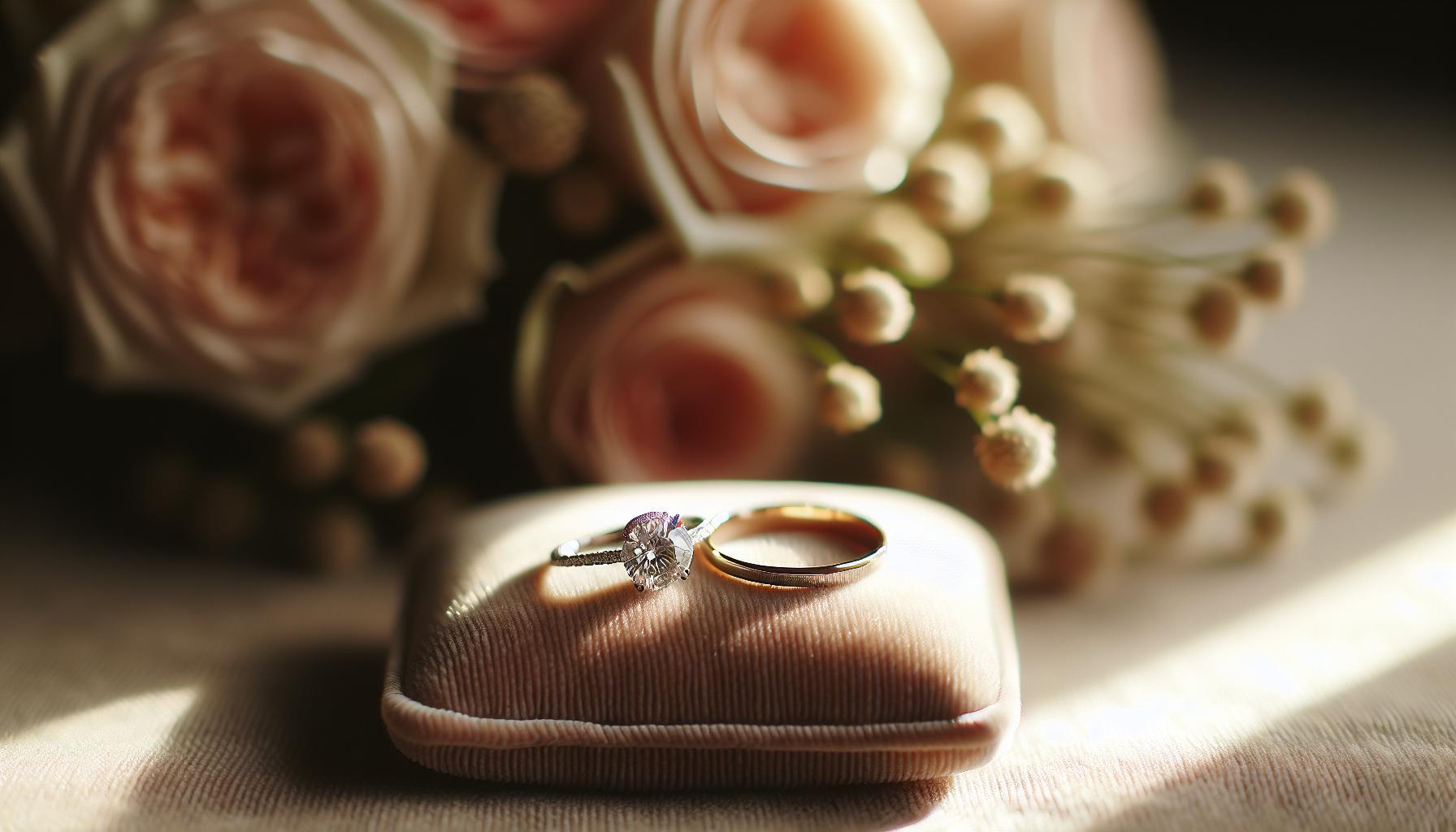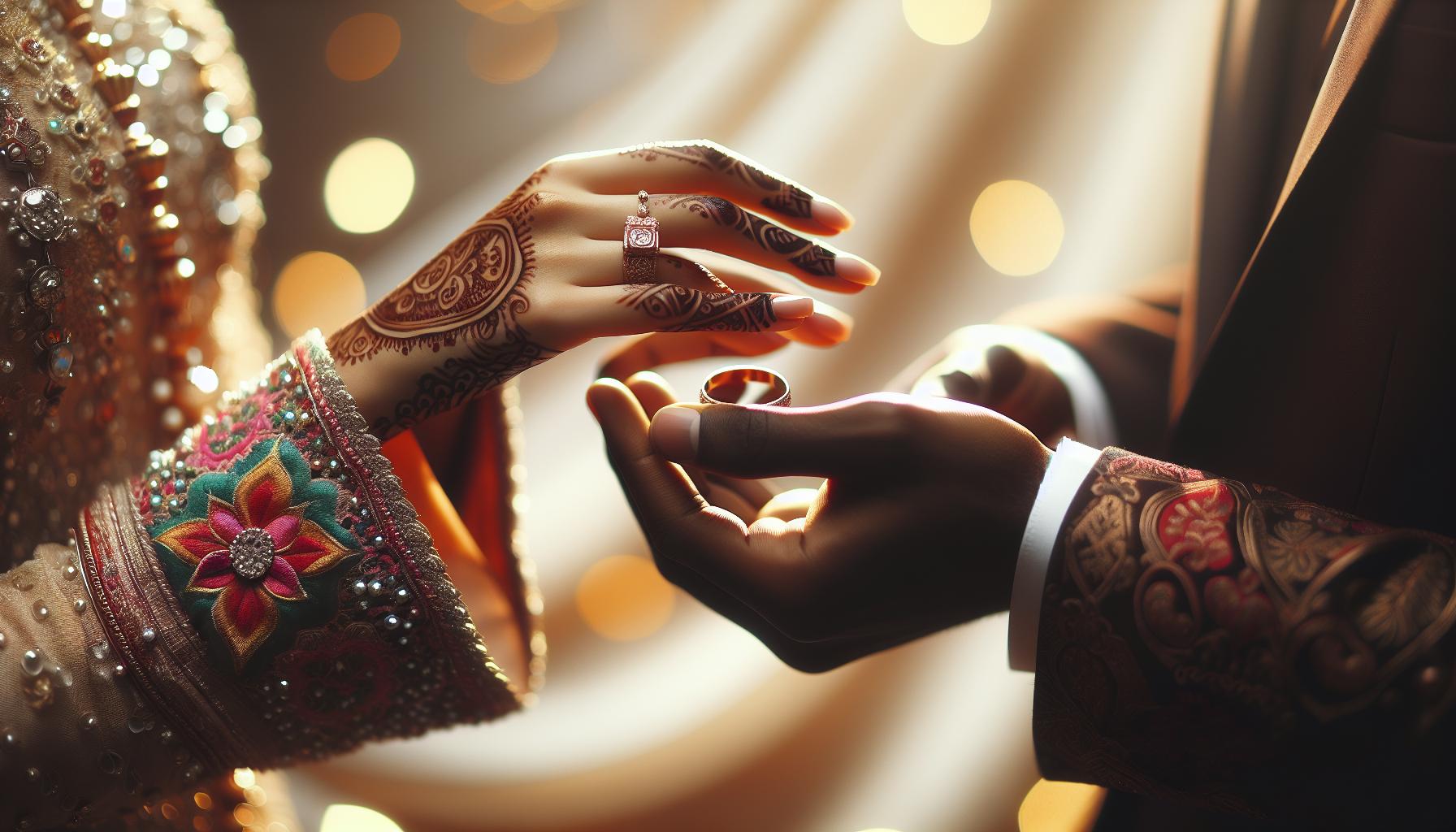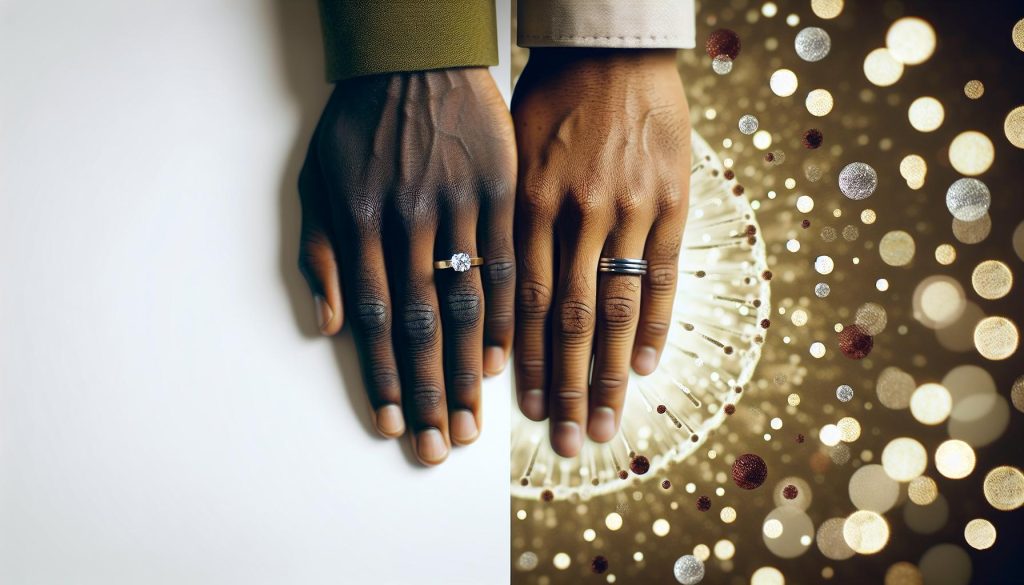When it comes to love and commitment, two symbols often take center stage: the engagement ring and the wedding ring. While both represent significant milestones in a relationship, they serve distinct purposes and carry unique meanings. Understanding the difference between these two rings is essential for couples navigating their wedding journey, ensuring clarity in tradition and personal significance. As you plan your special day, it’s natural to have questions about these cherished symbols. Dive into this topic, and uncover the nuances that separate engagement rings from wedding bands, enriching your approach to choosing the perfect tokens of your love. Whether you’re deciding on styles, stones, or everything in between, this exploration will guide you in making informed choices that resonate with your romantic vision.
Is an Engagement Ring Different from a Wedding Ring?
Choosing the perfect ring to symbolize your love can feel like navigating a thrilling adventure filled with emotion and significance. An engagement ring and a wedding ring are distinct pieces that hold unique meanings, serving as cherished reminders of different milestones in your relationship. While they may often be worn together, their purposes are quite different. The engagement ring is typically presented during the proposal and signifies the promise of marriage, while the wedding ring is exchanged during the wedding ceremony, symbolizing the commitment and vows shared between partners.
The Distinction in Purpose
The primary difference between the two lies in their symbolic meanings and occasions for giving. An engagement ring is a token of intention; it’s a way to ask, “Will you marry me?” This ring is generally designed to stand out, often featuring a prominent gemstone, usually a diamond, which symbolizes love and fidelity. In contrast, the wedding ring is more understated and represents a pledge to love and cherish one another for eternity. It is typically a simple band, often crafted in precious metals like gold or platinum, worn by both partners after they say “I do.”
Design and Style Variations
When it comes to the design, engagement rings tend to be more elaborate, often showcasing a single stone with intricate settings, whereas wedding rings are generally simpler and can even have matching or complementary styles. Couples may choose to have their wedding bands engraved, adding a layer of personalized intimacy that reflects their united journey.
- Engagement Ring: Typically features a central gemstone, often in a more intricate design.
- Wedding Ring: Generally a plain band or a subtle design, symbolizing the marriage commitment.
Understanding these differences empowers couples to select rings that resonate with their love story while honoring the traditions that make their commitment unique. Embrace this journey with excitement, as each ring you choose will be a meaningful representation of your love, marking significant moments along your shared path.
The Purpose Behind Engagement and Wedding Rings
Choosing the perfect rings to symbolize your love is a momentous step in any relationship, rich with emotions and significance. The purpose of an engagement ring and a wedding ring is rooted in tradition but is deeply personal to each couple. Understanding these distinct purposes can add layers of meaning to your special journey together.
An engagement ring is typically a beautiful testament to the promise of marriage, often given during a heartfelt proposal. This ring signifies not just an intention to marry, but also a commitment to a future filled with shared dreams and challenges. Usually adorned with a prominent and stunning gemstone, the engagement ring serves as a statement piece that captures the essence of romance and anticipation. Couples often choose diamonds for their durability and brilliance, but other gemstones can be just as meaningful, representing individuality and personal connection.
In contrast, the wedding ring symbolizes a more profound commitment-one that is acknowledged publicly during the wedding ceremony. Exchanged as part of the vows, these rings embody the pledge to cherish and support each other for a lifetime. Wedding bands are often simpler in design, reflecting a sense of unity and equality between partners. Many couples opt for matching styles, which can further reinforce their bond and shared journey.
Each ring, while different in purpose, tells a part of your love story. When selecting these significant symbols, think about what each represents for you and your partner. Whether it’s the sparkle of an engagement ring or the timelessness of a wedding band, remember that these tokens are reminders of your unique commitment and shared future. Embrace the process as you create lasting memories through your choices, and allow your love story to be reflected in every detail of your rings.
By understanding the distinct purposes of engagement and wedding rings, couples can make informed choices that resonate with their relationship’s unique narrative, creating cherished symbols that they’ll carry with them through life.
Understanding the Symbolism of Engagement vs. Wedding Rings
The journey of love is beautifully marked by two significant rings: the engagement ring and the wedding band. Each of these rings carries its own unique symbolism, which plays a crucial role in expressing commitment and devotion. Understanding these meanings not only elevates the emotional significance of each piece but also informs your choices as you select the perfect rings to represent your love story.
An engagement ring is often seen as a symbol of hope and promise. Traditionally presented during a proposal, this ring signifies the intention to marry and the deep commitment that accompanies that promise. It often features a prominent gemstone, typically a diamond, which embodies strength and resilience-key traits for a lifelong partnership. The extravagant nature of engagement rings, with their eye-catching designs and brilliant stones, reflects the excitement and anticipation of your shared future, making it a memorable part of the proposal. Couples might also choose alternative gemstones that resonate more personally, choosing colors or stones that represent their unique bond.
In contrast, wedding rings represent a deeper commitment, one that is celebrated in front of family and friends during the wedding ceremony. Exchanged at the altar, these rings symbolize unity and the promise of a shared life. While they tend to be more understated in design than engagement rings, wedding bands often come in matching styles that reinforce the sense of partnership and equality between spouses. These rings, worn daily, serve as constant reminders of the vows taken and the journey embarked upon together, representing enduring love.
Ultimately, both the engagement ring and the wedding band fulfill unique yet complementary roles in the narratives couples create together. As you navigate the excitement of selecting these rings, consider their distinct symbols-the promise of the future and the commitment to share your lives-as they each contribute to the beautiful tapestry of your relationship.
A Guide to Ring Styles: Engagement vs. Wedding Rings
When embarking on the beautiful journey of selecting engagement and wedding rings, understanding the styles available can significantly enhance the experience, making it both enjoyable and meaningful. Each ring type reflects a unique narrative of love, commitment, and personal aesthetics. While engagement rings are typically extravagant and brimming with symbolism, wedding bands often embrace a simpler elegance, designed for everyday wear while maintaining their profound significance.
For engagement rings, the styles can range from classic solitaires to intricate halo designs adorned with multiple smaller diamonds. Solitaires emphasize the beauty of a single stone, often chosen for its size and clarity, making it a timeless option. Halo settings, on the other hand, encircle the central gem with smaller stones, enhancing the visual impact and giving the impression of a larger diamond. Couples may also consider colored gemstones-like sapphires or emeralds-as centerpieces, adding a personal touch that reflects their unique love story.
When it comes to wedding bands, options abound, allowing for personalization and matching styles with the engagement ring. Traditional plain metallic bands are ever-popular, often crafted from gold, platinum, or palladium. More modern designs might feature engraved patterns, mixed metals, or even set stones, providing a unique twist that speaks to the couple’s style. Many couples choose to coordinate the styles of their wedding bands to symbolize their partnership, while others may opt for individual designs that still share a common theme, such as a specific metal or finish.
Ultimately, exploring the myriad of styles available not only helps couples find rings that resonate with their hearts but also transforms the process into an exciting part of their love story. Whether leaning towards the timeless elegance of a diamond-studded engagement ring or the understated charm of a classic wedding band, the choices available ensure that every couple can express their love uniquely. Embrace the journey, as each ring becomes a cherished reminder of your commitment and the beautiful adventure you are embarking on together.
Common Materials and Gemstones for Each Ring Type
Choosing the perfect materials and gemstones for engagement and wedding rings is a delightful journey into the world of love and commitment. The options available not only reflect personal styles but also embody deep sentiments associated with each ring’s significance. Whether you lean towards timeless elegance or modern flair, understanding the common materials and stones can help you make informed decisions that resonate with your love story.
Common Materials for Engagement and Wedding Rings
Both engagement rings and wedding bands are predominantly crafted from materials that symbolize durability and beauty, ensuring they stand the test of time. The most popular choices include:
- Gold: Available in various hues such as yellow, white, and rose, gold is a classic choice for its warmth and versatility. Each color has its unique appeal, with yellow gold exuding traditional charm and white gold offering a modern feel.
- Platinum: Known for its strength and rarity, platinum is a premium choice that signifies lasting commitment. Its hypoallergenic properties make it ideal for sensitive skin, while its natural sheen elevates any design.
- Palladium: A more affordable alternative to platinum, palladium is lightweight yet durable, making it a popular option for wedding bands.
Gemstone Selections: Diamonds and Beyond
Diamonds continue to reign supreme in the realm of engagement rings, symbolizing eternal love with their brilliance and fire. When considering the perfect gem, explore:
- Natural Diamonds: Frequently associated with engagements, these stones come in various shapes and qualities, allowing for a personalized touch in selecting the perfect ring.
- Lab-Grown Diamonds: An ethical alternative that’s gaining popularity, lab-grown diamonds offer the same beauty and durability as their natural counterparts, often at a lower price point.
- Colored Gemstones: For those looking to break tradition, sapphires, emeralds, and rubies present stunning options as center stones, providing a burst of color and personal flair.
As you select materials and gemstones for your rings, remember that these choices reflect your unique bond and personal aesthetics. Whether you opt for the classic sparkle of a diamond or the rich hue of a sapphire, each ring will ultimately tell a story of love and commitment, capturing the essence of your shared journey. Embrace this exciting chapter with thoughtful consideration, and let each detail symbolize the love you cherish.
What Do Engagement and Wedding Rings Cost?
The investment in engagement and wedding rings can vary significantly based on personal preferences, styles, and budgets. Typically, an engagement ring is seen as a one-time purchase intended to symbolize love and commitment, while wedding rings are often simpler and are exchanged during the wedding ceremony, making them a different kind of investment altogether. According to various jewelry industry insights, the average cost of an engagement ring is around $6,000, but prices can range from a few hundred dollars to tens of thousands, influenced by factors such as the type of metal, the quality of the gemstone, and brand reputation.
Factors Influencing Costs
When budgeting for these significant pieces of jewelry, consider the following elements:
- Type of Metal: As discussed earlier, gold and platinum come at different price points. Platinum is generally more expensive due to its density and rarity.
- Gemstone Choice: Natural diamonds can be costly, particularly those with high clarity and carat weight. In contrast, lab-grown diamonds or alternative gemstones like sapphires or moissanite can be more budget-friendly.
- Design Complexity: Custom designs or intricate settings often carry a higher price tag. Simple bands are typically less expensive but can still be personalized.
- Branding: Purchasing from a well-known jeweler can increase the cost due to brand prestige and service, including warranties and return policies.
Average Costs Breakdown
Here’s a rough breakdown of what you might expect when budgeting for these rings:
| Type of Ring | Average Cost Range |
|---|---|
| Engagement Ring | $1,000 – $20,000+ |
| Wedding Ring (for her) | $500 – $3,000 |
| Wedding Ring (for him) | $200 – $2,000 |
Ultimately, while these rings represent a financial investment, they also embody deep sentimental value. It’s essential to prioritize what resonates with you as a couple, allowing love to dictate your choices rather than societal expectations. Make this journey enjoyable and filled with personal touches, ensuring that both your engagement and wedding rings beautifully reflect your unique bond and dreams for the future together.
Cultural Differences: How Engagement and Wedding Rings Vary
In the intricate world of wedding traditions, the significance of engagement and wedding rings varies dramatically across cultures, each weaving its own delightful narrative of love and commitment. For instance, in many Western cultures, the engagement ring is typically a flashy piece, often adorned with a diamond. It’s presented during a proposal, symbolizing a promise of marriage. On the other hand, the wedding ring-usually simpler and exchanged during the ceremony-serves as a token of the vows made. This distinction highlights not just a difference in aesthetics but also in the ritual significance associated with each ring.
Across the globe, the customs surrounding these rings can differ significantly. For example, in some Asian cultures, it’s customarily the bride’s family that presents jewelry as marriage gifts, which could include intricate, handcrafted pieces instead of a traditional engagement ring. In India, couples typically wear two rings during ceremonies-the engagement ring, often quite ornate, and a plain wedding band, representing simplicity and practicality. Likewise, in Scandinavian countries, men may also choose to wear an engagement ring, signifying their commitment alongside their female counterparts.
Another fascinating cultural angle can be observed in various Indigenous communities, where rings might not even play a role in the engagement or wedding process. Instead, the emphasis may be on other forms of commitment tokens, such as ceremonial gifts or symbolic gestures that represent unity and shared life journeys. These culturally rich practices show that love and commitment can manifest in many wonderful ways, transcending the conventional ring-giving approach.
Regardless of the cultural nuances, the discussions surrounding engagement and wedding rings encourage couples to explore and honor traditions that resonate with their heritage or personal preferences. This journey not only enriches the engagement and wedding experience but also strengthens the couple’s bond as they create their unique narrative amidst the beautiful kaleidoscope of traditions.
The Timeline: When to Buy Each Type of Ring
Timing is everything, especially when it comes to selecting the perfect symbols of love and commitment. Engaging with the timeline for purchasing engagement and wedding rings is not just about practicality, but also about weaving a beautiful narrative into your journey together. The engagement ring, typically presented during a proposal, often sets the tone for the relationship’s next chapter. This pivotal moment usually signals the beginning of wedding planning. It’s wise to start the engagement ring search at least three months before the proposal. This allows ample time to explore various styles, budget considerations, and personal preferences without feeling rushed. Considering custom designs? Factor in additional time for consultations and manufacturing.
Once the engagement ring is secured and the joyous proposal has taken place, attention shifts to the wedding ring. Couples generally purchase wedding rings about two to three months before the wedding date. This timeline accommodates potential resizing and provides the opportunity for thoughtful discussions about styles and materials that resonate with both partners. It’s not uncommon for couples to coordinate their wedding bands with the engagement ring to create a cohesive look.
Important Considerations
As you navigate these timelines, here are several key points to keep in mind:
- Budget Planning: Ensure you set a clear budget for both rings early on. This will guide your choices and prevent any last-minute stress.
- Research Styles: Take time to understand the different styles available for both engagement and wedding rings. This can include solitaire settings, halo settings, or even intricate custom designs that reflect your personal love story.
- Consult Trusted Sources: Seek advice from family and friends who have recently gone through the process or consult professional jewelers to gather insights and referrals.
Starting these purchases early allows couples to savor the experience rather than feel pressured. By thoughtfully working through the timelines and involving each other in the process, it can turn what may seem like a task into an enchanting part of your love story. Each ring will not only be a symbol of your commitment but also a cherished memory of the journey you took to find it together.
How to Choose an Engagement Ring that Suits Her Style
Choosing the perfect engagement ring is one of the most exciting milestones in your journey toward commitment, and it can also feel a bit overwhelming. But don’t worry-this is an opportunity to express your love and admiration through a beautiful piece of jewelry that she will cherish forever. Start by considering her personal style: is she more of a classic, timeless type of person, or does she gravitate toward modern, trendy designs? Observing her everyday jewelry can provide invaluable insights-do you often see her wearing gold or silver, or does she prefer colored gemstones over diamonds?
Another important factor is the ring’s shape and setting. While-traditionally-a round brilliant diamond is the most popular choice, other shapes like oval, pear, or emerald cut can add a unique touch that resonates with her personality. Similarly, the setting can dramatically influence the ring’s overall feel. Options include solitaire settings for a classic look, halo settings for added sparkle, or even vintage-inspired styles that offer a touch of romance. If your partner values sustainability, consider seeking out vintage rings or those made from ethically sourced materials.
Explore Customization Options
In the quest to find that perfect ring, personalization plays a vital role. Many jewelers offer custom design options, allowing you to collaborate on a ring that reflects her aesthetic. This can include selecting the metal type, choosing a unique stone arrangement, or engraving a meaningful phrase that captures the essence of your relationship. Not only will this ensure that the ring is one-of-a-kind, but it will also show her the thoughtfulness behind your choice.
Ultimately, the engagement ring is not just about the stone, the setting, or the metal-it’s about the love and commitment it represents. When selecting the ring, communicate openly about her preferences and involve her in the process, if that resonates with both of you. This level of collaboration can further strengthen your bond. Remember, the goal is to celebrate the beautiful journey you are about to embark on together, and choosing a ring that suits her style is just the beginning of that adventure.
Customizing Your Rings: Options for Personalization
Choosing a ring that embodies your love story is an exhilarating part of the engagement journey. Customizing your rings offers a delightful opportunity to create something truly special and personal, ensuring your symbols of commitment reflect your unique relationship. The process can be as simple or intricate as you desire, sparking creativity while honoring the sentimental value of these pieces.
To start, think about the metal choice-do you envision a classic gold, a modern platinum, or a warm rose gold? Each metal not only has its aesthetic appeal but also varies in durability and maintenance. Engaging with your partner’s style here can inform a choice that resonates deeply with her.
Next, consider stone selection. While diamonds are the traditional choice, colored gemstones like sapphires, emeralds, or even moissanite can add a personal touch. These stones often carry their own meanings and can convey sentiments that align with your partner’s personality. Furthermore, you might explore unique cuts and settings, whether it’s a delicate halo design, a vintage-inspired style, or a simple solitaire. Each option tells a story, highlighting significant aspects of your love.
Personalization extends beyond material choices. Including an engraving-a meaningful date, a line from a favorite poem, or a personal mantra-infuses an extra layer of intimacy into the ring. This subtle yet profound detail transforms a beautiful piece of jewelry into a treasured heirloom.
Lastly, consider design collaboration with a jeweler. Many artisans are eager to create bespoke pieces that encapsulate personal narratives, guiding you through options while honing your vision into a tangible masterpiece. This hands-on experience not only results in stunning rings but also enriches the journey of crafting your love symbol together.
By embracing the personalization possibilities, you make the engagement and wedding rings genuinely yours-drenched in meaning and celebration, marking the start of a beautiful new chapter together.
Engagement and Wedding Ring Traditions Explained
From ancient traditions to modern interpretations, engagement and wedding rings are rich symbols of love and commitment, each steeped in unique rituals and customs. In many cultures, the engagement ring is often presented during a proposal and signifies the promise of marriage, while the wedding ring is exchanged during the wedding ceremony as a symbol of the vows taken. Understanding these distinctions can deepen the meaning behind each ring.
One tradition rooted in history is the wearing of the engagement ring on the fourth finger of the left hand, known as the “ring finger.” It is believed that a vein in this finger, the “vena amoris,” runs directly to the heart, which lends a romantic sentiment to wearing a ring in this location. In contrast, many couples choose to wear their wedding bands alongside their engagement rings, creating a beautiful unified symbol of their marital bond. Some choose to wear the wedding ring on the bottom, symbolizing the everlasting bond created during the marriage ceremony.
Cultural variations add another layer of richness to ring traditions. In some cultures, such as in parts of Europe, both partners wear engagement rings, while in others, only the bride does. In many Latin American countries, it is common to exchange both engagement and wedding rings during the engagement, often adorned with religious symbols that reflect family heritage. Additionally, in some Asian cultures, the bride may receive a gold ring that signifies the family’s wealth and social status, providing economic assurance to the marriage.
In terms of the timing for presenting these rings, traditions vary widely. In Western culture, an engagement ring is typically given during a proposal, while wedding bands are exchanged during the exchange of vows. Other cultures may have additional ceremonies or rituals associated with the ring-giving process, which can include blessings from family members or religious connotations.
These rituals not only commemorate the love shared but also embody the journey each couple takes toward their future together. Whether choosing personalized designs or adhering to longstanding customs, understanding the traditions behind engagement and wedding rings allows couples to embrace their unique story as they embark on this special chapter of life together.
Ring Care: Maintaining Your Precious Symbols of Love
Your engagement and wedding rings are not just beautiful pieces of jewelry; they are cherished symbols of your love and commitment. Proper maintenance of these rings ensures they remain as radiant and meaningful as the day you exchanged them. By taking care of these precious items, you can preserve their beauty and longevity, allowing them to be a part of your journey for many years to come.
Routine Cleaning
Maintaining the sparkle of your rings begins with regular cleaning. To keep them looking their best, follow these simple steps:
- Soak: Combine warm water with a few drops of mild dish soap in a small bowl.
- Brush: Use a soft-bristled toothbrush to gently scrub the stones and settings, paying special attention to the underside where dirt can accumulate.
- Rinse and Dry: Rinse in clean water and dry with a soft, lint-free cloth to restore shine.
For deeper cleaning every few months, consider professional services, especially for pieces with intricate details or multiple gemstones.
Safe Storage
When you’re not wearing your rings, proper storage is essential. Store them in separate compartments of a jewelry box or in individual pouches to prevent them from scratching each other. Avoid leaving them in damp places like bathrooms, as moisture can lead to tarnishing and damage over time. Keeping your rings in a cool, dry environment will help maintain their brilliance and integrity.
Annual Inspections
Just as you would get a check-up for your health, consider an annual inspection for your rings. A professional jeweler can assess the settings and stones for any wear and tear. They can also tighten loose stones, so you won’t risk losing a precious gem. Annual visits to your jeweler can help ensure your rings remain secure and sparkly.
Be Mindful of Activities
While it can be tempting to wear your rings at all times, certain activities can increase the risk of damage. Remove your rings before engaging in household chores, exercising, or swimming. Chemicals found in cleaning products or chlorine in pools can be detrimental to the stones and metals used in your rings.
By embracing these simple care tips, your engagement and wedding rings can continue to shine brightly, reflecting the cherished moments of your love story. Remember that these rings symbolize more than beauty; they signify a promise and a journey you are taking together, making their care a celebration of your unique love.
Frequently asked questions
Q: What is the main difference between an engagement ring and a wedding ring?
A: The main difference lies in their purpose; an engagement ring is given at the proposal to signify a promise of marriage, while a wedding ring is exchanged during the wedding ceremony as a symbol of the couple’s commitment. For a deeper understanding, visit the section on “Is an Engagement Ring Different from a Wedding Ring?” in the article.
Q: Can you wear an engagement ring and a wedding ring together?
A: Yes, many brides choose to wear both rings together on the same finger. Often, the wedding band is placed closest to the heart, with the engagement ring worn above it. For tips on styling your rings, see the section on “A Guide to Ring Styles.”
Q: Is it necessary to have both an engagement ring and a wedding band?
A: While it’s not strictly necessary, many couples opt for both to represent different stages of their commitment. The engagement ring often features a diamond or gemstone, while the wedding band is typically a simpler band. For cost considerations, refer to “What Do Engagement and Wedding Rings Cost?”
Q: When do couples typically buy engagement and wedding rings?
A: Engagement rings are usually purchased before the proposal, while wedding rings are often bought closer to the wedding date. It’s wise to plan ahead to ensure both rings reflect your style. Check the “Timeline: When to Buy Each Type of Ring” for more detailed guidance.
Q: What are some popular styles for engagement and wedding rings?
A: Popular styles for engagement rings include solitaire, halo, and vintage settings, while wedding bands often range from simple gold to diamond-studded designs. For a comprehensive overview, explore “A Guide to Ring Styles: Engagement vs. Wedding Rings.”
Q: How do cultural differences affect engagement and wedding ring traditions?
A: Cultural traditions can greatly influence how and when rings are exchanged. For example, some cultures may wear engagement rings on different fingers or have unique designs. To learn more, refer to the section on “Cultural Differences: How Engagement and Wedding Rings Vary.”
Q: What materials are commonly used for engagement and wedding rings?
A: Common materials for engagement rings include gold, platinum, and various gemstones, while wedding bands are often made from similar metals. Explore the article’s “Common Materials and Gemstones for Each Ring Type” for more specifics.
Q: How should I care for my engagement and wedding rings?
A: Proper care involves regular cleaning with gentle soap and water, avoiding harsh chemicals, and ensuring safe storage when not in use. Visit “Ring Care: Maintaining Your Precious Symbols of Love” for more detailed care tips.
In Retrospect
Understanding the difference between an engagement ring and a wedding ring is essential as you embark on your wedding planning journey. While both symbolize love and commitment, they each carry unique significance in the relationship. Now that you know the distinctions, why not explore beautiful options to celebrate your love? Check out our stunning selection of wedding rings or discover exquisite eternity rings that can beautifully complement your wedding band.
Don’t miss out on finding the perfect symbol of your love-visit us today! If you have more questions about wedding rings or need guidance through the wedding planning process, our resources are here to support you every step of the way. Share your thoughts or experiences in the comments below, and let’s keep the conversation going! Together, we can make your wedding planning journey as magical as the day itself.











